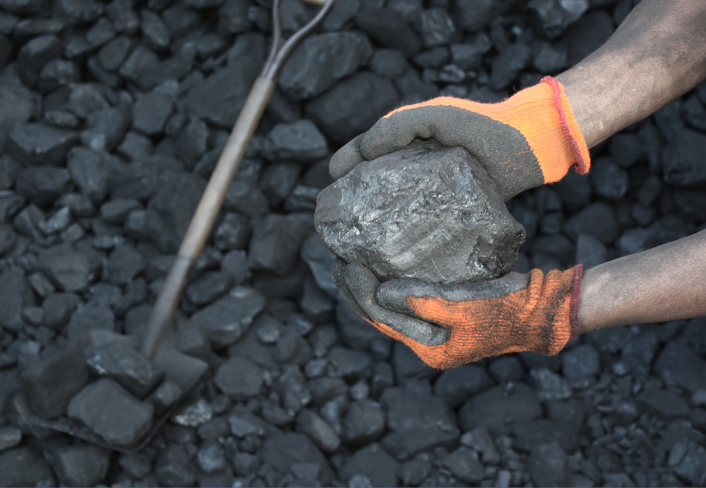
Spotlight Series: Coal & Renewables
Paul Baruya
By Paul Baruya, Director of Strategy and Sustainability
Welcome to part 2 of our Spotlight Series. In this segment, I will discuss how coal and renewables complement each other.
In my previous article, I explained why coal can be a sustainable energy source. Please read if you have not done so already.
In this post, I will explain how coal and renewables complement each other to provide reliable, clean, and affordable energy. How renewables need coal for manufacturing, and why investment in renewables and coal should be equitable.
Renewables Need Coal for Manufacturing
Wind and solar power are often seen as “cleaner” substitutes for fossil fuels. However, it’s less widely recognised that they also have a carbon footprint linked to the extraction and processing of raw materials.
Interestingly, coal plays a significant role in the production of wind turbines.
In fact, coal is crucial in creating many of the materials used in the construction of wind turbines. This is particularly true in China, a global frontrunner in both coal production and wind turbine manufacturing.
On average, to build a wind turbine each megawatt of wind needs 260 tonnes of steel.
Given that most of the world’s steel is derived from blast furnace iron, a wind turbine may require on average 170 tonnes of coking coal to convert 300 tonnes of iron ore.
While Solar Photovoltaics (PV) don’t require as much steel, they do necessitate the use of silicon.
The growth of Solar PV has been remarkable in recent years. Annual capacity additions escalated from 20 GW/year in 2010 to 40 GW/year in 2014, and further to 97 GW/year in 2017. In 2022, Solar PV capacity additions reached a record high of 220 GW, marking a 13% increase from 2021, as reported by the International Energy Agency (IEA).
Silicon is the primary material used in the production of Solar PV. It is the most prevalent semiconductor material in solar cells, accounting for approximately 95% of the modules sold. Silicon-based solar cells offer a blend of relatively higher-efficiency and lower cost.
Some can last for 25 years with around 20% degradation.
An often-overlooked fact is the role of coal in the production of solar-grade silicon.
The production of 1 tonne of silicon requires approximately 6 tonnes of raw materials (excluding electrodes). The breakdown of these requirements is as follows:
- 7 tonnes of quartz
- 5 tonnes of low ash coal or charcoal
- 5 tonnes of wood, and
- 13,000 kWh of electricity (Critical Raw Materials Alliance).
The total production volume of silicon worldwide in 2022 was estimated to be around 8.8 million metric tonnes (Mt) the volume of carbon in the form of low ash coal and charcoal needed is around 13 Mt, and the electricity demand is 114 TWh.
Under the IEA STEPS, solar panel production could potentially surge from 1145 GW in 2022 to 12,600 GW by 2050 due to the glut of solar manufacturing capacity that has developed. This could result in a demand for as much as 100 Mt of coal, solely for silicon production. The carbon required for silicon production might necessitate the implementation of carbon capture technologies.
Today, coal generates over 60% of the electricity used for global solar PV manufacturing, significantly more than its share in global power generation (36%) (IEA, 2023).
As the power sector moves towards decarbonisation, the role of coal in the clean energy transition could become increasingly significant. This is due to the anticipated increase in demand for materials like steel and silicon, which are integral to the manufacturing of wind turbines and solar PV.
Coal Provides 24/7 Energy
Coal plays a crucial role in supporting renewable energy sources by ensuring grid stability and a continuous power supply, which is vital for preventing power outages, particularly given the intermittent nature of renewable energy.
In 2022, the average global capacity factors for solar and wind were found to be just 12.9% and 26.9% respectively. These figures can fluctuate, with offshore wind occasionally reaching 30-40%, or even dropping to zero at times. Even in sun-drenched India, the performance of solar power has not been as impressive as anticipated.
The concept of dependable capacity, often overlooked by critics of coal power, is significant.
Despite its environmental challenges, coal provides a reliable and consistent energy source, which is indispensable for any functioning economy.
Moreover, it is not practical to replace 55% of the world’s reliable thermal generation solely with weather-dependent renewables.
Innovative approaches to generating power from fossil fuels must be incorporated into strategies to decarbonise electricity and heavy industry.
Established technologies such as carbon capture and storage (CCS), ammonia, and sustainable biomass have the potential to significantly reduce CO2 emissions from fossil fuels without compromising the security, flexibility, and affordability of electricity supply.
A prime example of coal abatement technologies and renewable energy working in tandem comes from China. The innovative Kubuqi project, a 16 GW plant powered by solar (8GW), wind (4GW), and coal (4GW), demonstrates how coal can collaborate with renewables to deliver clean energy.
As this section shows, choosing one fuel over the other is not feasible nor realistic. If we are to be successful in our transition to clean energy, we need all fuels and all technologies on the table. Coal has demonstrated time and again throughout this energy crisis that it can complement renewables. Projects, such as the Kubuqi project, proves coal can successfully integrate with renewables to produce clean energy.
Coal and Renewable Investment
Drawing from my background in environmental technology, I’ve observed with a sense of disappointment how the levelised cost of electricity (LCOE) for gas, coal, oil, and even nuclear energy consistently outperformed solar and wind power in every scenario. Back in the 1990s, the costs associated with emission controls were seldom internalised, resulting in an incomplete picture.
Fast forward thirty years, and analysts are still utilising the LCOE, repeating the same frustrating errors, but this time with a bias towards solar and wind power, thereby presenting observers with an incomplete picture yet again.
The concealed costs of backing up and stabilising grid supplies are frequently overlooked or outright excluded.
A more accurate measure of the total system cost of an energy unit exists, known as the Value Adjusted Cost of Electricity (VALCOE). VALCOE accounts for additional value considerations in power systems, reflecting the cost associated with technology deployment. It incorporates factors such as reliability, energy storage capabilities, and the cost of carbon.
As grids become increasingly saturated with solar and wind power, and as gas prices exhibit volatility, VALCOE emerges as a more accurate metric for assessing market competitiveness. It facilitates a comparison of available technologies for long-term energy development planning.
For example, coal plants operate continuously, providing power 24/7, unlike intermittent energy sources that are affected by weather or day-night cycles. Coal plants also have the advantage of stockpiling coal for potential energy storage and a reliable fuel supply, making them resilient during periods of high demand or limited renewable energy output.
In our collaborative research with the ASEAN Centre for Energy (ACE), we compare the impacts of investing US $26 billion in upgrading existing subcritical coal power plants in the ASEAN region to ultra-supercritical, or in constructing offshore wind farms.
We found that upgrading coal power plants from subcritical to ultra supercritical would:
- Avoid annual emissions of 60 million tonnes (Mt) CO₂.
- Equivalent to removing 31.5 million cars per year from the roads.
- The crucial takeaway here is that energy security would remain intact, with coal continuing to serve as a robust and reliable form of power generation.
If the same $26 billion were redirected towards the construction of offshore wind farms, rather than investing in cutting-edge coal technology, the outcomes would be as follows:
- They would result in fewer emissions being avoided (35.8 MtCO₂ vs 60 MtCO2).
- The limited capacity factor of wind would only allow for the construction of enough wind capacity to replace 7 GW of subcritical coal power.
- It would equate to removing fewer cars off the road at approximately 19 million.
While wind power may lack flexibility, the incorporation of battery storage costs could potentially enable renewables to narrow the dependability gap with thermal power generators. However, it’s important to note that these additional costs are not factored into the LCOE.
This is where the Value Adjusted Cost of Electricity (VALCOE) comes into play. VALCOE provides a more comprehensive understanding of the costs and value associated with different energy sources. It aids in making informed decisions by considering both economic and system reliability aspects.
Cost of Energy
Now, let’s turn our attention to energy prices across Europe.
The wholesale cost of offshore wind in certain parts of Europe is projected to increase significantly, by up to 66%. Despite this, the decarbonisation of fossil fuels continues to face skepticism.
It is crucial to acknowledge that the process of decarbonising global energy will inevitably incur costs.
Policies related to government and finance should avoid propagating the idea that substituting fossil fuels with renewables will invariably lead to lower electricity tariffs. Such an assumption is premature at this stage.
This misconception is particularly harmful during an energy crisis. The underperformance of renewables and the overdependence on intermittent energy sources have demonstrated that these claims lack substantiation.
The crux of the matter is the importance of diversity, respecting the capabilities and energy resources available to nations and governments, especially in scenarios where alternatives to coal are limited.
Summary
Advanced coal technologies, like many other technologies, are not complete solutions in themselves. However, they are a vital component of the abatement strategies we need to adopt. They can serve as a bridge between the current and future energy needs of developing and emerging countries, while mitigating the environmental impact of coal and providing support to renewables during periods of unreliability.
Paul’s biography:
Paul Baruya is the Director of Strategy and Sustainability at the FutureCoal.
He comes with a background in environmental consultancy at AEA Technology (now Ricardo), where he devised the New Entrant Reserve CO2 allocation for new power plants and industrial facilities and was involved in numerous projects involving end-user energy efficiency and CO2 reduction campaigns.
He also has experience in long-term forecasting and modelling of global coal and gas markets at IHS Global Insight (now IHS Markit), and energy use and emissions from power generation, steel, cement, and transport sectors.
Previous to FutureCoal, Paul was a senior analyst at the International Centre for Sustainable Carbon, a Technology Collaboration Programme of the IEA, studying the cost structures of mining, coal and gas competition in Asia, energy in Africa, and global biomass resources.
More recently, Paul joined FutureCoal, where he supports advocacy for advanced coal abatement technologies and the strategic role of coal in developing economies.
Paul graduated from Imperial College with an MSc in Environmental Technology.


